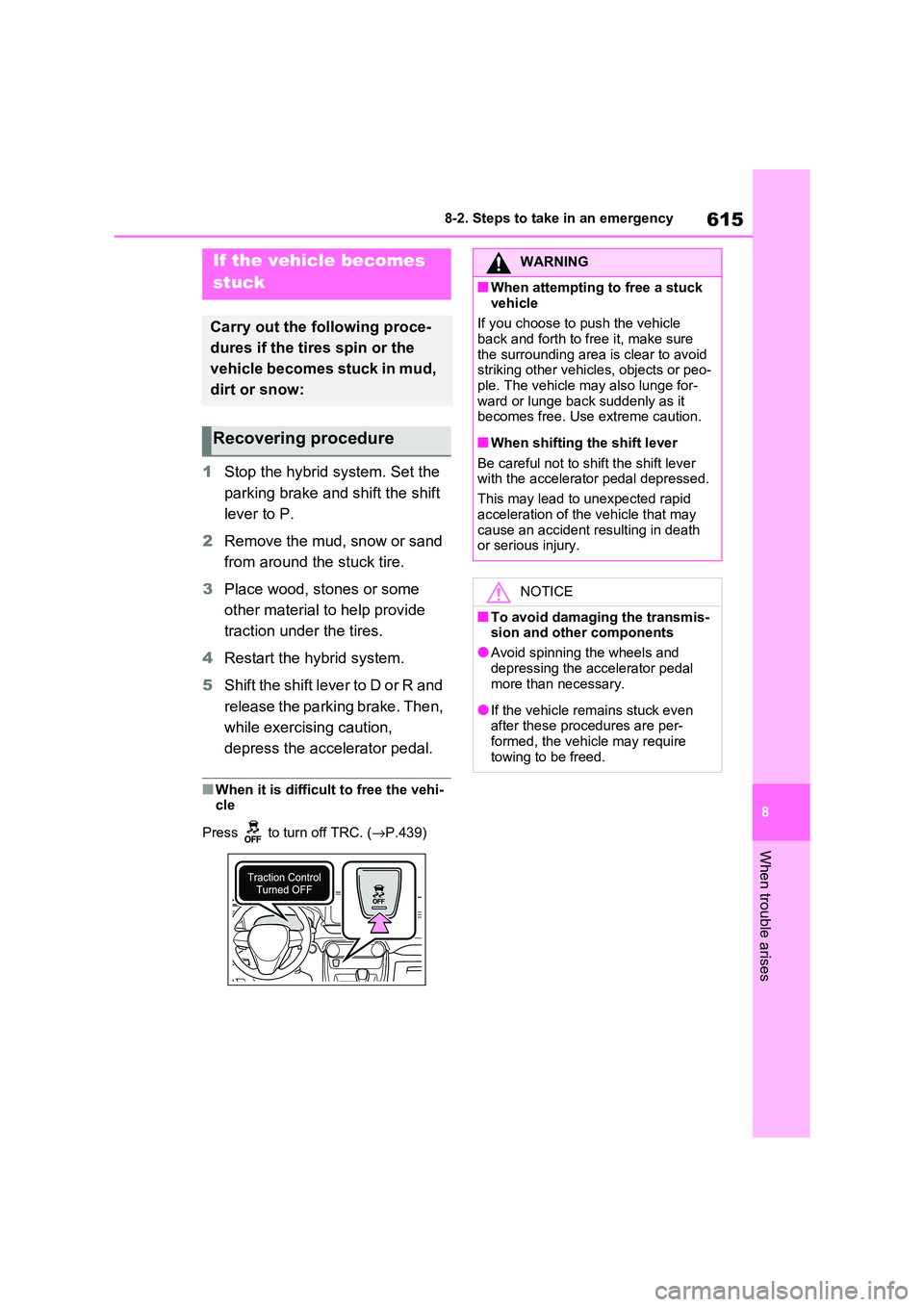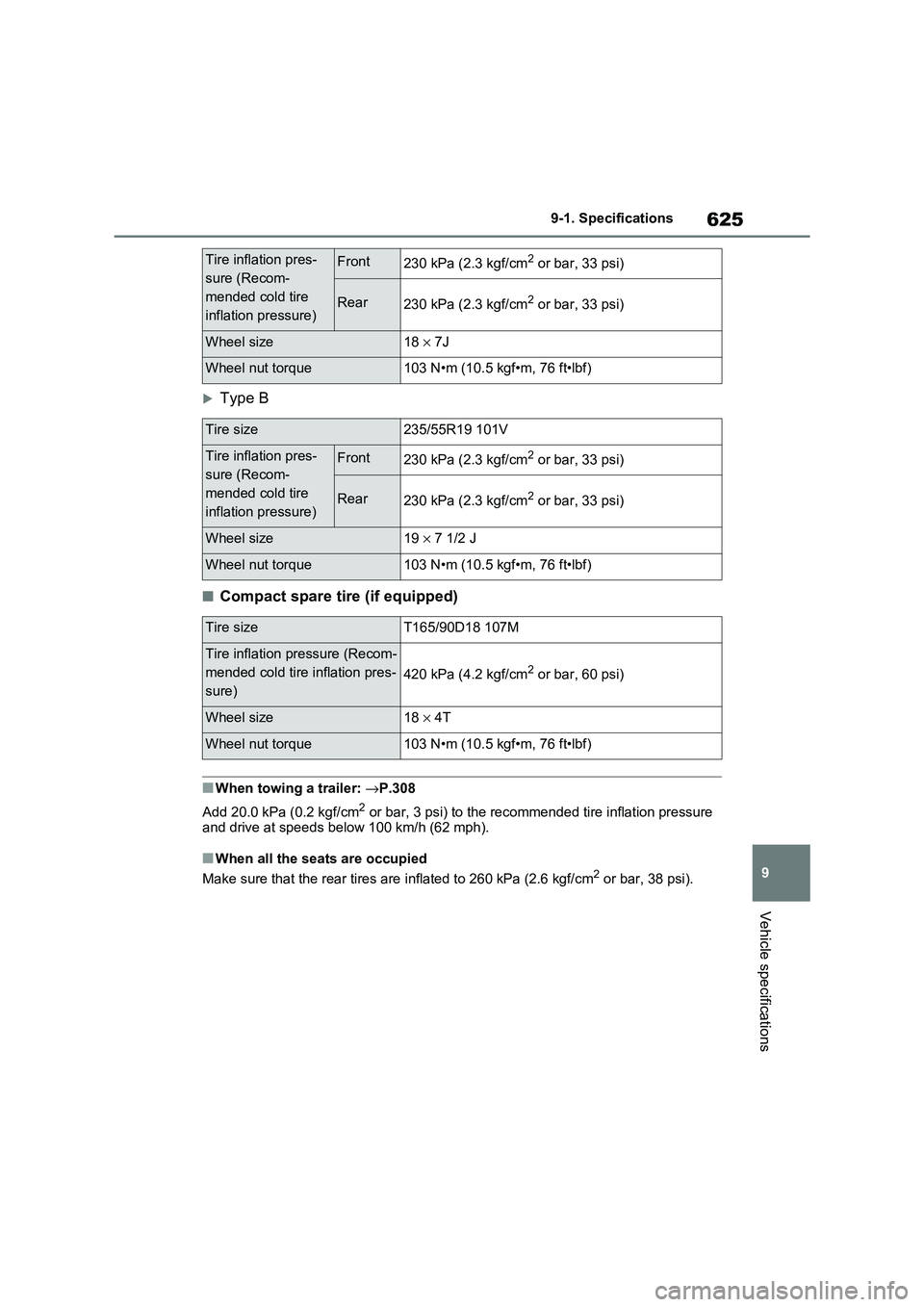Page 600 of 666

5988-2. Steps to take in an emergency
If foreign matter is on the wheel contact
surface, the whee l nuts may loosen while the vehicle is in motion, causing
the tire to come off.
2 Install the spare tire and loosely
tighten each wheel nut by hand
by approximately the same
amount.
Turn the wheel nuts until the washers
come into contact with the disc
wheel .
3 Lower the vehicle.
4 Firmly tighten each wheel nut
two or three times in the order
shown in the illustration.
Tightening torque: 103 N•m (10.5 kgf•m, 76 ft•lbf)
5 Stow the flat tire, tire jack and all
tools.
■The compact spare tire
●The compact spare tire is identified by
the label “TEMPORARY USE ONLY” on the tire sidewall.
Use the compact spar e tire temporar-
ily, and only in an emergency.
●Make sure to check the tire inflation
pressure of the compact spare tire. ( →P.625)
■When using the compact spare tire
As the compact spare tire is not
equipped with a tire pressure warning
valve and transmitter, low inflation pres -
sure of the spare tire will not be indi - cated by the tire pressure warning
system. Also, if you replace the compact
spare tire after the ti re pressure warning light comes on, the light remains on.
■When the compact spare tire is
attached
The vehicle height may become lower when driving with the compact spare tire
compared to when driving with standard
tires.
A
B
Page 601 of 666
599
8
8-2. Steps to take in an emergency
When trouble arises
■If you have a flat front tire on a road
covered with snow or ice (except 235/55R19 tires)
Install the compact spare tire on one of
the rear wheels of t he vehicle. Perform
the following steps and fit tire chains to the front tires:
1 Replace a rear tire with the compact spare tire.
2 Replace the flat front tire with the tire removed from the rear of the vehicle.
3 Fit tire chains to the front tires.
■Certification for the jack
Page 603 of 666

601
8
8-2. Steps to take in an emergency
When trouble arises
One of the following may be the
cause of the problem:
The AC charging cable may be
attached to the vehicle.
( →P.135)
The electronic key may not be
functioning properly. ( →P.604)
There may not be sufficient fuel
in the vehicle’s tank.
Refuel the vehicle. ( →P.342)
There may be a malfunction in
the immobilizer system. ( →P.76)
There may be a malfunction in
the steering lock system.
The hybrid system may be mal-
functioning due to an electrical
problem such as electronic key
battery depletion or a blown fuse.
However, depending on the type
of malfunction, an interim mea -
sure is available to start the
hybrid system. ( →P.602)
There is a possibility that the
NOTICE
■Driving with tire chains and the
compact spare tire
Do not fit tire chai ns to the compact spare tire.
Tire chains may damage the vehicle
body and adversely a ffect driving per- formance.
■When replacing the tires
When removing or fitting the wheels, tires or the tire pressure warning
valve and transmitter, contact any
authorized Toyota ret ailer or Toyota authorized repairer, or any reliable
repairer as the tire pressure warning
valve and transmitter may be dam - aged if not handled correctly.
If the hybrid system will
not start
Reasons for the hybrid system
not starting vary depending on
the situation. Check the follow -
ing and perform the appropri -
ate procedure:
The hybrid system will not
start even though the cor -
rect starting procedure is
being followed ( →P.317)
Page 617 of 666

615
8
8-2. Steps to take in an emergency
When trouble arises
1 Stop the hybrid system. Set the
parking brake and shift the shift
lever to P.
2 Remove the mud, snow or sand
from around the stuck tire.
3 Place wood, stones or some
other material to help provide
traction under the tires.
4 Restart the hybrid system.
5 Shift the shift lever to D or R and
release the parking brake. Then,
while exercising caution,
depress the accelerator pedal.
■When it is difficult to free the vehi - cle
Press to turn off TRC. ( →P.439)
If the vehicle becomes
stuck
Carry out the following proce -
dures if the tires spin or the
vehicle becomes stuck in mud,
dirt or snow:
Recovering procedure
WARNING
■When attempting to free a stuck
vehicle
If you choose to push the vehicle back and forth to free it, make sure
the surrounding area is clear to avoid
striking other vehicles, objects or peo - ple. The vehicle may also lunge for -
ward or lunge back suddenly as it
becomes free. Use extreme caution.
■When shifting the shift lever
Be careful not to sh ift the shift lever
with the accelerator pedal depressed.
This may lead to unexpected rapid
acceleration of the vehicle that may
cause an accident resulting in death or serious injury.
NOTICE
■To avoid damaging the transmis - sion and other components
●Avoid spinning the wheels and
depressing the accelerator pedal
more than necessary.
●If the vehicle remains stuck even
after these procedures are per - formed, the vehicle may require
towing to be freed.
Page 620 of 666

6189-1. Specifications
9-1.Specifications
*: Unladen vehicle
■Vehicle identification number
The vehicle identification number
(VIN) is the legal identifier for your
vehicle. This is the primary identifi -
cation number for your Toyota. It is
used in registering the ownership of
your vehicle.
On some models, this number is
stamped on the top left of the
instrument panel.
Maintenance data (fuel, oil level, etc.)
Dimensions
Overall length*4600 mm (181.1 in.)
Overall width*1855 mm (73.0 in.)
Overall height*With18-inch wheels1685 mm (66.3 in.)
With19-inch wheels1690 mm (66.5 in.)
Wheelbase*2690 mm (105.9 in.)
Tread*
With18-inch wheelsFront1605 mm (63.2 in.)
Rear1625 mm (64.0 in.)
With19-inch wheelsFront1595 mm (62.8 in.)
Rear1615 mm (63.6 in.)
Weights
Gross vehicle mass2510 kg (5534 lb.)
Maximum permissible axle capacityFront1265 kg (2789 lb.)
Rear1315 kg (2899 lb.)
Drawbar load70 kg (154 lb.)
Towing capacityWithout brake750 kg (1653 lb.)
With brake1500 kg (3307 lb.)
Vehicle identification
Page 626 of 666
6249-1. Specifications
*: The fluid capacity is the quantity of reference.
If replacement is necessary, cont act any authorized Toyota retailer or Toyota
authorized repairer, or any reliable repairer.
*: Minimum pedal clearance when depr essed with a force of 300 N (30.5 kgf, 67.4
lbf) while the hybri d system is operating.
■Full-size tire
Type A
Rear differential (rear electric motor)
Fluid capacity*1.7 L (1.8 qt., 1.5 Imp.qt.)
Fluid typeToyota Genuine ATF WS
NOTICE
■Rear differential fluid type
Using differential fluid other than the above type may cause abnormal noise or vibration, or ultimate ly damage the differential of your vehicle.
Brakes
Pedal clear-
ance*
Left-hand drive
vehicles128 mm (5.0 in.) Min.
Right-hand drive
vehicles95 mm (3.7 in.) Min.
Pedal free play1.0 ⎯ 6.0 mm (0.04 ⎯ 0.24 in.)
Fluid typeSAE J1703 or FMVSS No. 116 DOT 3
SAE J1704 or FMVSS No. 116 DOT 4
Steering
Free playLess than 30 mm (1.2 in.)
Tires and wheels
Tire size225/60R18 100H
Page 627 of 666

625
9
9-1. Specifications
Vehicle specifications
Type B
■Compact spare tire (if equipped)
■When towing a trailer: →P.308
Add 20.0 kPa (0.2 kgf/cm2 or bar, 3 psi) to the recomme nded tire inflation pressure and drive at speeds bel ow 100 km/h (62 mph).
■When all the seats are occupied
Make sure that the rear tires are inflated to 260 kPa (2.6 kgf/cm2 or bar, 38 psi).
Tire inflation pres-
sure (Recom -
mended cold tire
inflation pressure)
Front230 kPa (2.3 kgf/cm2 or bar, 33 psi)
Rear230 kPa (2.3 kgf/cm2 or bar, 33 psi)
Wheel size18 × 7J
Wheel nut torque103 N•m (10.5 kgf•m, 76 ft•lbf)
Tire size235/55R19 101V
Tire inflation pres-
sure (Recom -
mended cold tire
inflation pressure)
Front230 kPa (2.3 kgf/cm2 or bar, 33 psi)
Rear230 kPa (2.3 kgf/cm2 or bar, 33 psi)
Wheel size19 × 7 1/2 J
Wheel nut torque103 N•m (10.5 kgf•m, 76 ft•lbf)
Tire sizeT165/90D18 107M
Tire inflation pressure (Recom-
mended cold tire inflation pres -
sure)
420 kPa (4.2 kgf/cm2 or bar, 60 psi)
Wheel size18 × 4T
Wheel nut torque103 N•m (10.5 kgf•m, 76 ft•lbf)
Page 640 of 666

6389-2. Customization
■LTA (Lane Tracing Assist)* (→P.362)
*: If equipped
■RSA (Road Sign Assist)*1 (→P.372)
*1: If equipped
*2: RSA function becomes on when the power switch is turned to ON.
*3: If a Speed limit with supplemental mark is exceeded, the notification buzzer does
not operate.
*4: Vehicles with navigation system
FunctionDefault
setting
Customized
setting
Lane centering functionOnOff–O–
Steering assist functionOnOff–O–
Alert typeSteering wheel
vibrationBuzzer–O–
Alert sensitivityHighStandard–O–
Vehicle sway warning functionOnOff–O–
Vehicle sway warning sensitivityStandardLow–O–High
FunctionDefault
setting
Customized
setting
RSA (Road Sign Assist)*2OnOff–O–
Excess speed notification
method*3Display only
No notification
–O–Display and
buzzer
Excess speed notification level2 km/h (1 mph)5 km/h (3 mph)–O–10 km/h (5 mph)
No-overtaking notification
methodDisplay only
No notification
–O–Display and
steering wheel
vibration
Other notifications method (No-
entry notification)*4Display only
No notification
–O–Display and
buzzer
ABC
ABC